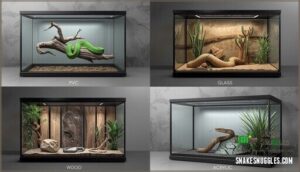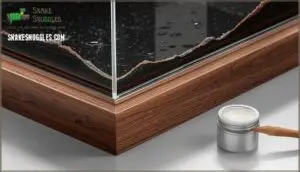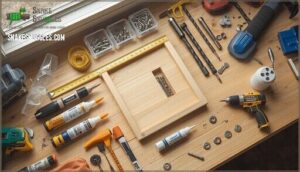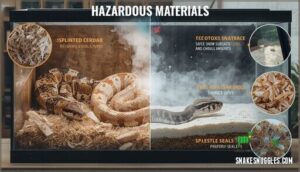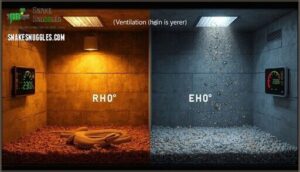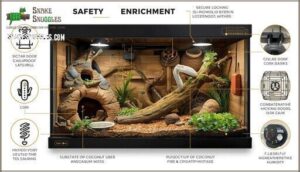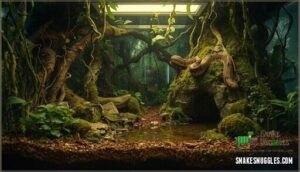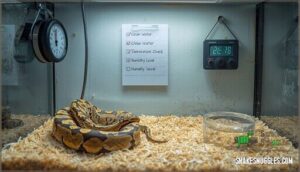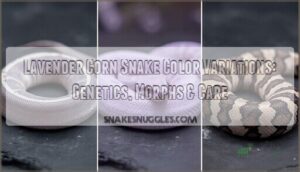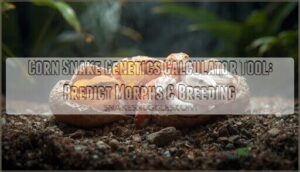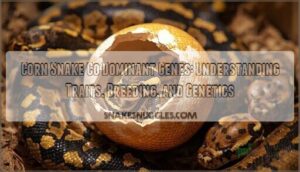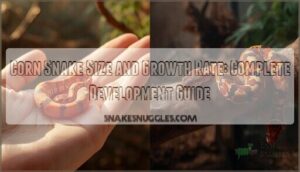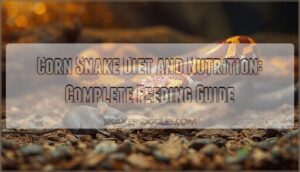This site is supported by our readers. We may earn a commission, at no cost to you, if you purchase through links.

Custom snake enclosure design flips that script, treating each build as a chance to create a world customized to your animal’s instincts. When you line up the right measurements, pick sturdy, safe materials, and factor in the subtle details—ventilation, enrichment, even the way light moves across a ledge—your snake gets more than shelter.
It gets a living space that grows with it, keeping body and mind truly healthy.
Table Of Contents
- Key Takeaways
- Planning Your Custom Snake Enclosure
- Selecting Materials and Construction Techniques
- Designing for Ventilation and Climate Control
- Ensuring Snake Health and Safety
- Adding Enrichment and Functional Features
- Maintenance and Long-Term Care Tips
- Frequently Asked Questions (FAQs)
- How to build a custom snake enclosure?
- What tools do you need to build a snake enclosure?
- Who manufactures custom snake cages & enclosures?
- How does snake development affect a custom enclosure?
- What is a snake enclosure?
- How do I create a functional snake enclosure?
- How can I automate feeding schedules in enclosures?
- What lighting types best enhance snake coloration?
- How to soundproof a snake enclosure for quiet rooms?
- What insurance options cover expensive custom habitats?
- Conclusion
Key Takeaways
- The size, materials, and layout of your snake’s enclosure should match your animal’s current and future needs, prioritizing room to stretch and natural behaviors.
- Safe, non-toxic materials, proper sealants, and strategic vent placement are essential for keeping your snake healthy and minimizing risks from moisture, escapes, and environmental hazards.
- Real enrichment comes from environmental complexity, including appropriate hides, climbing structures, and the option to use bioactive or traditional setups, all tailored to your snake’s species.
- Smart monitoring tools and a diligent maintenance routine help maintain stable temperature, humidity, and cleanliness, supporting your snake’s long-term well-being.
Planning Your Custom Snake Enclosure
Before you start building, think about what your snake will need now and as it grows. The right enclosure balances size, safety, and comfort.
Let’s look at the key steps to help you shape the perfect home.
Measuring for Current and Future Snake Size
How do you get accurate measurements for snake length, and why does it matter? Determining a snake’s size isn’t just about stretching out a tape measure. Snake growth charts show rapid early gains; using a flexible measuring tape and comparing parental sizes, you can predict growth rate and future needs. This guides enclosure size requirements and future scaling factors. Scientific studies support this need.
- Use soft measuring tape for precision
- Track growth rate with periodic checks
- Reference parental size for estimation
- Adjust plans based on projected space needs
Choosing Enclosure Dimensions and Layout
Once you know your snake’s present and projected length, align enclosure size to evidence-based minimum dimensions—often, two-thirds of adult length for the main tank, with 25-50% extra for spatial enrichment.
Design layouts to allow full extension, include vertical space for climbing, and incorporate thermal gradients. Modular designs let your setup adapt as growth charts signal new space allocation needs.
A good rule of thumb is to make certain the snake can stretch fully within its enclosure.
Species-Specific Habitat Requirements
Moving from enclosure size to specific needs, matching habitat details to the snake species becomes its own science. Ball Pythons need tighter humidity levels than Corn Snakes, while arboreal snakes thrive with more vertical space and complex branches.
Think thermal gradients, appropriate lighting needs, and spatial complexity—each choice influences snake behavior and growth planning, shaping healthy routines as your reptile matures.
Researching Design Inspiration and Trends
Once you’ve matched habitat conditions to your snake’s needs, it’s time to gather real-world inspiration. Look at current enclosure design features—bioactive setups that mimic nature, minimalist displays with smart integration, and material innovations that highlight both style and ethical sourcing.
Popular snake enclosure ideas blend aesthetics and technology, showing how custom snake enclosure design evolves alongside trends in reptile enclosure design.
Selecting Materials and Construction Techniques
Materials set the stage for a safe and thriving habitat, but your choices will shape every aspect of the build. As you weigh your options, consider how each one bolsters your snake’s health and your long-term plans.
Let’s walk through the most effective materials and construction techniques for custom enclosures.
Wood, Glass, Acrylic, and PVC Options
When you’re choosing materials and construction techniques for your enclosure, each choice shapes your snake’s safety and living environment. PVC offers excellent material insulation and is easy to move, while glass prizes visual clarity but loses heat quickly. Wood provides tactile appeal and custom options, yet requires vigilance. Acrylic blends light weight, clarity, and durability—though it scratches easier.
- PVC: Best for stability, easy cleaning, and energy savings.
- Glass: Great for displays, but loses warmth and chips easily.
- Wood: Classic, customizable, but needs care for long-term safety.
- Acrylic: Lightweight, clear, but watch for scratches and handling.
Safe Sealants and Waterproofing Methods
With every enclosure build, picking a waterproof sealant is the difference between years of trouble-free use and slow moisture damage. Aquarium-safe silicone offers proven reliability—just allow a full 72-hour silicone curing time to avoid VOC off-gassing.
Here’s a quick comparison to help you weigh your sealing techniques and natural sealant options:
| Sealant Type | Key Benefit |
|---|---|
| Aquarium-Safe Silicone | Reliable, inert barrier |
| Epoxy Resin | Maximum waterproofing |
| Polyurethane | UV and moisture resistance |
| Natural Oils | Low-VOC, eco-friendly |
Tools and Assembly Essentials
For a custom snake enclosure, reliable tools are the backbone of any DIY project. You’ll want:
- Cutting tools for clean panels
- Fasteners hardware for sturdy assembly
- Measuring equipment for perfect fit
- Adhesives sealants for moisture control
- Safety workspace gear for your protection
Using the right, nontoxic materials and prioritizing tool safety and assembly turns building snake enclosures into a safe success.
Avoiding Toxic Materials and Common Pitfalls
Ever wondered how a safe home turns hazardous for your snake? Pine, cedar, and cheap PVC can spell trouble—think VOC off-gassing, toxic woods, and microscopic residues from cleaning. Overlooked, these can jeopardize reptile health.
Choose nontoxic materials, verify sealant safety, guard against moisture damage, and inspect ventilation. Small mistakes with material breakdown often grow into big risks for reptile safety.
Designing for Ventilation and Climate Control
Keeping your snake healthy hinges on steady airflow and the right climate. Ventilation and temperature control can make or break the setup. Here’s what you’ll want to think about next.
Effective Vent Placement and Airflow Management
Balanced airflow is a quiet but powerful ally for snake health. Strategic vent placement—think low on the cool side, high on the warm—lets you utilize natural convection for effective air exchange.
Paired vents or mesh strips strengthen ventilation and climate control. Factor in thermal dynamics and your snake’s species airflow needs before setting airflow management aside for smart humidity control next.
Integrating Humidity and Temperature Controls
Imagine a rainforest trapped in glass—managing climate control takes precision. Automated systems with well-placed sensors let you maintain temperature gradients and humidity control without a daily struggle.
Fine-tuned calibration matters, since even a small drift can risk your snake’s health. Pair dimming thermostats with efficient emitters, and use smart humidity techniques to keep environmental shifts gentle and stable.
IoT and Smart Monitoring Solutions
Tuning climate control with digital precision gets easier when you lean on remote monitoring and predictive analytics. Real-time temperature monitoring, humidity control, and automated control routines mean your smartphone becomes your best hygrometer.
Adding video integration gives you live behavioral checks, while encrypted data security and detailed logs provide peace of mind as you fine-tune your snake’s world from anywhere.
Preventing Respiratory and Moisture Issues
You can automate half your habitat, but nothing replaces smart ventilation strategies and proper air flow to prevent respiratory infections. Humidity control depends on more than gadgets—it’s the right substrate selection, reliable temperature gradients, and careful sealing techniques that keep trouble at bay. Moisture-resistant materials matter, but keen observation and practical habits seal the deal:
- Boost horizontal ventilation openings
- Monitor substrate moisture, avoiding oversaturation
- Prioritize multi-level venting for airflow
- Employ digital hygrometers for swift corrections
- Reseal seams annually to assure moisture resistance
Ensuring Snake Health and Safety
Your snake’s health and safety start with careful choices in how you build their home. There are a few key elements you can’t afford to overlook.
Here’s what you should pay attention to next.
Secure Latches and Escape-Proof Features
Even the most thoughtful enclosure can fall short if latch mechanisms aren’t perfect. Snakes exploit tiny gaps and loose edges, so prioritize escape-proof snake enclosures with rabbeted frames, aquarium-safe silicone, and at least double-action locks.
Material integration and routine maintenance protocols matter, while behavioral considerations guide you toward secure monitoring systems and adding security features that adapt as your snake grows, reducing escape risk.
Non-Toxic Finishes and Safe Substrates
Once you’ve installed locks and barriers, your next challenge is preventing VOC off-gassing and substrate impaction risks. Rely on reptile-safe sealants and nontoxic finishes, checking safety data for every product.
For substrate selection, prioritize pesticide-free, moisture-retaining substrates—think naturalistic bioactivity with aspen, coconut, or specialty soils—always verifying the substrate options you use don’t threaten your snake’s health.
Creating Temperature Gradients
When you create stable temperature gradients—warm on one end, cool on the other—you give your snake control over its own comfort and health. This means combining the right thermal gradient methods and heating solutions. For best results:
- Place thermostatically regulated heat sources at one end.
- Use digital probes for monitoring automation technology.
- Adjust for your species’ specific temperature needs.
Recognizing and Preventing Common Health Issues
Although your snake can’t tell you when something feels off, subtle signs often speak volumes. Watch for open-mouth breathing, bubbling at the nostrils, or dull scales—these may hint at respiratory infections, scale disorders, or early mouth rot.
Good ventilation, MBD prevention, and prompt cleaning shield against respiratory health issues, parasitic infestations, skin infections, and trouble with healthy shedding.
Adding Enrichment and Functional Features
Creating a richer habitat means more than just giving your snake a place to hide. Every extra feature you add can support natural behaviors and overall well-being.
Here’s what to think about as you plan the next stage for your enclosure.
Incorporating Hideouts and Climbing Structures
Think of your enclosure as a stage: Hide Placement and Structure Safety set the scene for healthy routines. Offering multiple hides and securely mounted climbing branches caters to Arboreal Needs, boosts behavioral enrichment, and fosters environmental enrichment.
Over time, proper hiding spots and enrichment benefits improve Long-Term Health, giving your snake confidence and more opportunities to thrive within its habitat.
Selecting Bioactive or Traditional Setups
Wondering if bioactive setups are worth the buzz? Here’s the honest rundown:
- Bioactive Benefits: promote natural behaviors, cut maintenance needs, and ease humidity control.
- Setup Costs: often 25–40% higher upfront but reduce expenses over time.
- Animal Welfare: enriches life and may boost health.
- Hygiene Risks: improper substrate selection or ventilation raises pathogen risk.
- Traditional builds: emphasize predictability and easier disinfection.
Providing Environmental Enrichment and Stimulation
Why settle for a bare minimum when you can offer your snake an environment teeming with opportunity? Sensory stimulation and environmental complexity go hand-in-hand—branches, varied textures, and hiding spots create behavioral enrichment that encourages natural exploration.
A thoughtful environmental enrichment approach, customized for species specificity, drives cognitive development and keeps snakes engaged. Rotate enrichment items regularly to mimic nature’s surprises.
Minimizing Odors and Maintenance Needs
Odor control starts with smart substrate choices and efficient airflow design. Coconut husk and bioactive substrates with microfauna can minimize enclosure odors by up to 40% while maintaining microbial balance for months.
Proper ventilation systems with cross-flow design reduce ammonia concentration by 60% and support humidity control and airflow management.
Smart sensors linked to automated cleaning cycles and moisture control systems keep conditions stable with less than 2% daily variance.
Install easy-access panels for routine waste removal—daily spot-cleaning cuts odor accumulation by 50–70% compared to irregular maintenance schedules.
Maintenance and Long-Term Care Tips
Keeping your snake healthy starts with a smart maintenance routine and a watchful eye on their habitat. There are a few key ways to keep your enclosure in top shape for the long haul. Here’s what to focus on next.
Routine Cleaning and Disinfection Practices
Regularly cleaning and disinfecting your snake’s enclosure isn’t just a chore—it’s essential for reptile safety and keeps diseases at bay. Stick to smart cleaning schedules, and use proven sanitization methods. Focus on biofilm removal to guarantee your maintenance efforts pay off.
Here’s how to strengthen your routine:
- Rotate disinfectant selection for each cleaning.
- Intensively scrub hidden crevices.
- Always air dry surfaces thoroughly.
Monitoring Temperature and Humidity Levels
Just as cleaning prevents pathogens from taking hold, Climate Monitoring ensures your habitat stays within safe boundaries.
Rely on Smart Devices—digital thermometers, Humidity Sensors, and thermostats—to keep temperature gradients stable and humidity control on point. Setting alerts for temperature regulation helps you respond quickly if readings shift.
Consistent tracking is the best insurance for your snake’s ongoing wellness.
Inspecting for Wear, Damage, and Safety
You’ve got your sensors working, but don’t overlook old-fashioned vigilance. Make Structural Checks routine—scan for seam separation in moisture-resistant materials and check weatherstripping around easy-access panels.
A thorough Wear Inspection spots vent damage that could compromise escape-proof snake enclosures.
Stick to clear Maintenance Schedules; scheduled Damage Assessment and Safety Protocols make sure both snake and habitat stay protected for the long haul.
Adapting The Enclosure as Your Snake Grows
Careful Growth Monitoring often reveals when it’s time for Size Adjustments in your custom snake enclosure. Don’t just watch the calendar—watch your snake’s length and activity. Consider these steps:
- Measure snake length regularly
- Check fit versus enclosure size
- Update thermal gradients and Humidity Control
- Plan Expansion and secure escapeproof features
- Prioritize snake health considerations as your snake matures
Frequently Asked Questions (FAQs)
How to build a custom snake enclosure?
Picture your snake gliding through a serene, custom-designed landscape. Building a custom snake enclosure involves choosing enclosure materials, integrating vibration dampening, planning for automation, and weaving in biosecurity measures, all while elevating enclosure acoustics and aesthetic design.
What tools do you need to build a snake enclosure?
You’ll need cutting tools for wood and PVC pipe, fastening tools for assembly, measuring tools for accuracy, and safety equipment for protection.
Include control tools for climate, and always use aquarium-safe silicone during final assembly.
Who manufactures custom snake cages & enclosures?
Even the best escape artists can’t outsmart the leaders behind American-made reptile enclosures like BlackBox Cages, Toad Ranch, and Reptile Kages.
Each specializes in custom snake enclosure builds, with diverse material choices, customization options, and evolving lead times for custom reptile habitats.
How does snake development affect a custom enclosure?
Snake development shapes every aspect of enclosure planning: rapid growth rates mean frequent upgrades, while behavioral adaptations call for space allocation and enrichment that matches species needs.
Proper development relies on enclosure size, supporting long-term welfare and instinctual needs.
What is a snake enclosure?
A snake enclosure, or reptile enclosure, is a purpose-built habitat designed for secure space and habitat replication.
Proper enclosure design aids thermoregulation, environmental enrichment, and snake welfare, fostering natural behaviors and maintaining stable, healthy snake habitats.
How do I create a functional snake enclosure?
Imagine the difference between a bare glass box and a space built for movement, comfort, and curiosity.
The difference between a bare glass box and a space built for movement, comfort, and curiosity defines meaningful habitat design
Enclosure Functionality means balancing Habitat Optimization, Space Utilization, Practical Design, and Efficient Features—think ventilation, safe substrate, hiding places, and ongoing environmental enrichment.
How can I automate feeding schedules in enclosures?
Feeding automation lets you schedule dispensing with smart feeders that track timing, portions, and conditions. Remote monitoring facilitates ventilation and humidity control.
However, balance routines—if systems overfeed, health impacts can include obesity or disrupted digestion, even with ideal air circulation.
What lighting types best enhance snake coloration?
Think of a prism revealing hidden hues—just so, UVB exposure, full-spectrum LEDs, and natural sunlight reveal deeper colors in your reptile habitat.
Effective ventilation, UVB lighting, and infrared benefits safeguard health and intensify color visibility in custom enclosures.
How to soundproof a snake enclosure for quiet rooms?
Achieving soundproof comfort means balancing Material STC Ratings and Vibration Dampening. Use mass-loaded vinyl or acoustic plasterboard, embrace decoupling methods, and seal joins with Acoustic Sealants.
Always maintain proper ventilation and prioritize Reptile Safety to reduce stress behaviors.
What insurance options cover expensive custom habitats?
Regarding habitat insurance needs, most homeowners policies require a policy endorsement for expensive custom reptile enclosures.
Specialized exotic pet coverage, supported by valuation and appraisal documentation, helps protect against claims and liability—ensuring your investment stays secure.
Conclusion
A well-built custom snake enclosure design is more than a shelter—it’s a passport, unlocking the world your snake was born to navigate. Each secure latch stands as a gate, every branch as a winding road.
Good design reflects respect for instinct and adaptation, shaping both safety and discovery into the landscape. What you build tells your snake it belongs.
The habitat becomes a living story, always ready for the next chapter, always grounded in your thoughtful care.
- https://www.datainsightsmarket.com/reports/reptile-enclosure-1905831
- https://www.marketreportanalytics.com/reports/snake-tanks-49478
- https://www.stumpscustomwood.com/keeping-up/top-5-affordable-pvc-reptile-enclosures-for-2025
- https://tempcube.io/blogs/temperature-humidity/iot-and-the-future-of-reptile-care-how-data-driven-insights-optimize-habitat-conditions
- https://talis-us.com/blogs/news/maintaining-optimal-conditions-in-snake-enclosures

